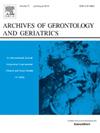青年痴呆症住院情况透视:一项利用行政数据进行的为期 8 年的全国性研究。
IF 3.5
3区 医学
Q2 GERIATRICS & GERONTOLOGY
引用次数: 0
摘要
摘要根据ICD-9-CM编码,描述葡萄牙公立医院中所有年龄小于65岁、主要或次要诊断为痴呆症的患者的特征:我们利用一个全国性数据库开展了一项回顾性观察研究,该数据库涵盖了 2008 年至 2015 年期间葡萄牙本土公立医院的所有住院和出院病例。根据ICD-9-CM代码290.1X-290.4X、291.2、292.82、294.1X、294.2X、331.0、331.1X、331.82、333.4和046.1(不包括诊断代码317-319、330.X、343、758.0-758.3和759.3),选取了主要或次要诊断为痴呆症的35-64岁住院患者。收集的信息包括年龄、性别、主要诊断、合并症(次要诊断)、入院类型、住院时间(LoS)、院内死亡率、自杀企图、出院目的地、再次入院和痴呆病因:在 7971 例住院病例中,有 5682 例住院患者,中位年龄为 57.3 岁(SD±6.5),61.8% 为男性。血管性痴呆是最常见的病因,其次是阿尔茨海默病。大多数入院患者都是急诊病人,主要诊断为 "谵妄、痴呆和其他认知障碍",其次是肺炎和酒精相关疾病。痴呆、脑血管疾病和糖尿病是最常见的合并症。总体而言,55.4%的入院患者是在研究期间首次入院,住院时间中位数为 10.0 天(第一季度;第三季度:5.0;20.0)。有 0.6% 的患者有自杀企图。院内死亡率为 9.2%,大多数患者出院回家(80.2%):这项研究描述了年轻痴呆症患者住院治疗的复杂性和压力,为进一步研究和有针对性的干预措施提供了详细的概述和建议。本文章由计算机程序翻译,如有差异,请以英文原文为准。
Insights into young-onset dementia hospitalizations: An 8-year nationwide study using administrative data
Objective
To characterize all Portuguese public hospitalizations of patients aged < 65 years with a primary or secondary diagnosis of dementia, based on ICD-9-CM coding.
Methods
A retrospective observational study was conducted using a nationwide database encompassing all hospitalizations occurred in Portuguese mainland public hospitals with discharge from 2008 to 2015. Hospitalizations of patients aged 35–64 years with primary or secondary diagnoses of dementia were selected based on ICD-9-CM codes 290.1X-290.4X, 291.2, 292.82, 294.1X, 294.2X, 331.0, 331.1X, 331.82, 333.4 and 046.1, excluding diagnostic codes 317-319, 330.X, 343, 758.0-758.3 and 759.3. Information on age, sex, primary diagnosis, comorbidities (secondary diagnosis), type of admission, length of stay (LoS), in-hospital mortality, suicide attempts, discharge destination, readmissions and dementia etiology was collected.
Results
From 7971 hospitalizations, for 5682 inpatients, the median age was 57.3 years (SD±6.5) and 61.8% were of male patients. Vascular dementia was the most prevalent etiology, followed by Alzheimer's disease. Most admissions were urgent and had a primary diagnosis of ‘Delirium, dementia and other cognitive disorders’, followed by pneumonia and alcohol-related disorders. Dementia, cerebrovascular disease and diabetes were the most common comorbidities. Overall, 55.4% of admissions were first-time admissions during the study period and the median LoS was 10.0 days (Q1;Q3: 5.0;20.0). Suicide attempts were recorded in 0.6% of the episodes. The in-hospital mortality rate was 9.2% and most patients were discharged home (80.2%).
Conclusions
This study describes the complexity and strain of young-onset dementia hospitalizations providing a detailed overview and recommendations for further research and tailored interventions.
求助全文
通过发布文献求助,成功后即可免费获取论文全文。
去求助
来源期刊
CiteScore
7.30
自引率
5.00%
发文量
198
审稿时长
16 days
期刊介绍:
Archives of Gerontology and Geriatrics provides a medium for the publication of papers from the fields of experimental gerontology and clinical and social geriatrics. The principal aim of the journal is to facilitate the exchange of information between specialists in these three fields of gerontological research. Experimental papers dealing with the basic mechanisms of aging at molecular, cellular, tissue or organ levels will be published.
Clinical papers will be accepted if they provide sufficiently new information or are of fundamental importance for the knowledge of human aging. Purely descriptive clinical papers will be accepted only if the results permit further interpretation. Papers dealing with anti-aging pharmacological preparations in humans are welcome. Papers on the social aspects of geriatrics will be accepted if they are of general interest regarding the epidemiology of aging and the efficiency and working methods of the social organizations for the health care of the elderly.

 求助内容:
求助内容: 应助结果提醒方式:
应助结果提醒方式:


